Updated July 14, 2024
Is one-bag travel realistic? It is for one-bag carry-on travel by nesting, a favourite among one-baggers. It allows them to pack their clothing, shoes, tech gadgets, and essentials in one bag for a long trip. I had the opportunity to test the method on a 46-day trip to Africa. Read on to see a detailed packing list with concrete examples of what and how to pack using nesting.
Table of Contents
- What is the ‘nesting’ approach to one-bag travel?
- One bag carry-on travel by nesting
- 1. Assess your commitment to one-bag travel
- 2. Choose bags capable of nesting
- 3. Research historical weather data
- 4. Be prepared to purchase at the destination
- 5. Adopt a minimalist approach to what’s packed
- 6. Choose clothing with pockets
- 7. Choose quality
- 8. Collect a variety of packing cubes and pouches
- 9. Work with a packing list
- 10. Take advantage of ‘freebies’
- Packing list: 46 days of one-bag carry-on travel by nesting
- One bag carry-on travel by nesting in practice
- Conclusion
What is the ‘nesting’ approach to one-bag travel?
Most dedicated one-baggers don’t limit themselves to a single bag. Travellers need to be mobile when exploring a destination, and carrying a 40-litre or 30-litre bag with all their stuff isn’t practical. That’s when a small, packable backpack, sling, or purse packed with daily essentials is a handy second bag.
With the nested approach to one-bag travel, a second or third bag nests inside the main bag until it’s needed.
For a broader description of the nested approach and what bags are suitable for nesting, see How to travel with just one carry-on bag using the nested approach.
One bag carry-on travel by nesting
This post is inspired by a request in a reader’s comments on the above mentioned article on the nested approach. One of the images in the post showed three bags (a rolling suitcase, a packable backpack, and a packable purse) at JFK on my way to Africa. The reader asked if I could elaborate with detailed descriptions and photographs of what I packed, which items were packed in each bag, and if the purse and backpack could nest inside the main bag.
Before sharing how and what I packed, here are a several considerations that guided my approach to nesting. I’ll frame them as tips.
1. Assess your commitment to one-bag travel
It’s not for everyone. Looking and feeling fashionable, having access to a wide choice of outfits, refusing to use vacation time to do laundry… these and many other factors influence your travel style and packing choices. They inevitably determine if bags end up as carry-on or checked luggage. We all have different needs and approaches to experiencing the joy of travel.
What’s your packing style? Here’s an interesting quiz to find out. Whatever your approach, hopefully there’s something of value in this post. If so, I’d love to hear from you in the comments.
2. Choose bags capable of nesting
Nesting bags must be capable of packing inside the main bag – empty, packed, or partially packed. They should be lightweight and packable to remain within an airline’s size and weight restrictions (and your desired maximum packed weight). A packable bag typically packs into a small pouch or lays flat inside the main bag.
(i) Standard carry-on bag
For my 46-day trip to Africa, I experimented with a rolling bag for the first time. For many years, I travelled with an Osprey Farpoint 40 travel backpack. Reluctant to abandon a backpack model, I chose a hybrid model: an Osprey Daylite Carry-On Wheeled 40 L Duffel, a rolling, soft-sided suitcase with detachable backpack straps.
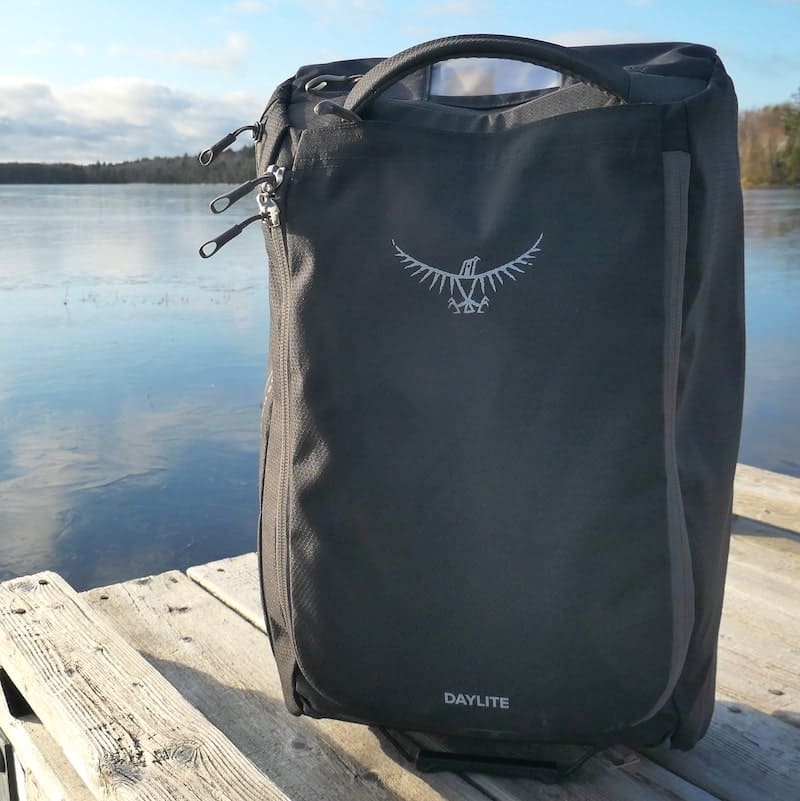
(ii) Packable backpack
The Osprey Ultralight Dry Stuff Pack is a waterproof backpack with two side pockets, ‘cinchable’ to secure a water bottle, travel umbrella, or easy-to-access essentials. It weighs 194 g / 6.8 oz, and with a capacity of 20 litres, it works well as an in-flight personal item and day bag.
(iii) Packable purse
The Tom Bihn Side Kick is a crossbody purse measuring 9.6 x 7.5 x 2.8 in / 24.5 x 19 x 7 cm and weighing 230 g / 8.1 oz. Partially packed, it lays flat inside the main bag. Empty, it can be stuffed into a small space.
(iv) Pocket shopping bag
I looked for a small, lightweight, packable pocket shopping bag that slid into a pocket of my purse or could be attached to exterior hardware. I found the perfect fit at a dollar store and used it frequently throughout the trip.
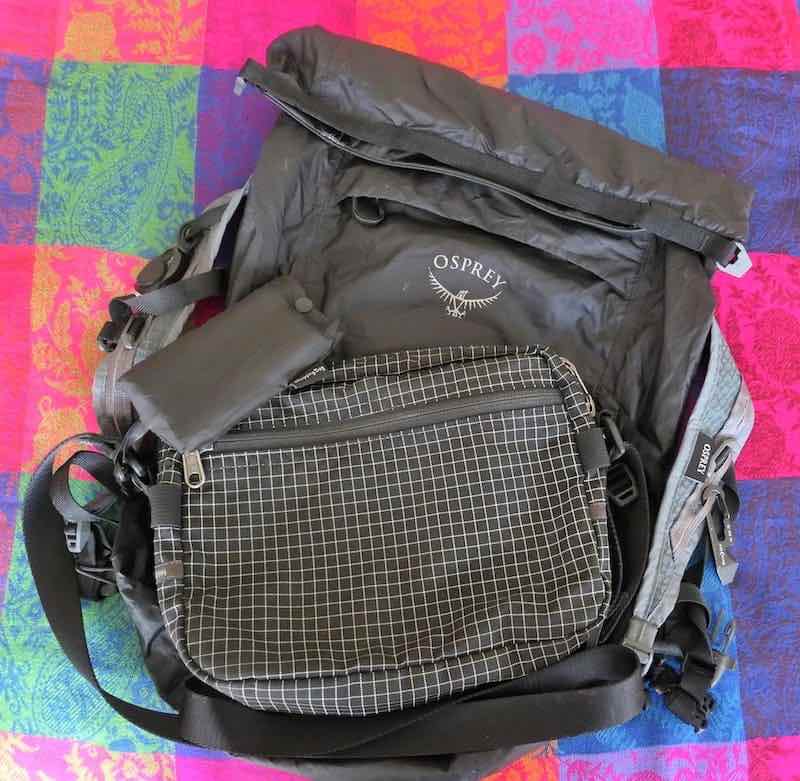
3. Research historical weather data
Numerous sites list average minimum and maximum temperatures, humidity levels, hours of sunlight, and frequency of rain and amounts. This type of data influences clothing, shoes, outerwear, and what to include in health and toiletries kits.
I needed to pack for temperatures between 8 and 34 degrees Celsius (46 to 93 Fahrenheit), with allowances for fluctuations at the lower and upper ends. After the cold winter months in southern Africa, temperatures rise in September. Still, early morning and evening game drives indicated the need to have warm gear. September is at the end of the dry season with little, if any, rain expected and little chance of exposure to malaria. This affected what was carried in a health kit and what I packed for sun protection.
4. Be prepared to purchase at the destination
While I’m not a fan of the ‘buy-it-there’ approach to packing light, if there’s a question of ‘Will I need it?’ I prefer to leave the ‘just-in-case’ item at home and purchase it at the destination. This applied to gear for cooler temperatures. If what I packed proved inadequate, I was prepared to pick up an extra fleece and donate it to a grateful recipient when it was no longer needed. As it turned out, what I packed worked perfectly.
5. Adopt a minimalist approach to what’s packed
I was travelling on five different airlines with variations in carry-on luggage restrictions and allowances. The most stringent was a limit of one bag not exceeding 8 kg / 17.6 lb. Most airlines allowed two bags, each with a maximum weight of either 7 kg or 9 kg. One airline permitted two bags with no specified weight limit, except that one had to fit under the seat in front and the other needed to be lifted into the overhead compartment without assistance.
This required aiming for a packed weight of 8 kg / 17.6 lb. My total packed weight was closer to 10 kg / 22 lb, so additional strategies were required to accommodate the extra 2 kg.
6. Choose clothing with pockets
What you wear doesn’t count against your carry-on allowance. It’s possible to find travel wear boasting a range of pockets. In my case, I have travel pants, leggings, a skort, shirts, hoodies, an under-clothing security waist belt, a multi-pocket travel vest and a jacket – all boasting one or more pockets. My SCOTTeVEST Lightweight Vest is like having a third carry-on bag. It weighs 400 g / 14 oz, and I can pack an assortment of stuff in its 20 pockets for a total weight of 3.3 kg / 7 lb 4 oz. Add a small, packable crossbody purse under the vest and out of sight, and the extra weight over my carry-on allowance became a non-issue.
Clothing with pockets is also handy when choosing a day bag (or not carrying a purse or bag). If essentials can be carried inside clothing, why bother with a bag?
7. Choose quality
Several Reddit forums are devoted to one-bag travel and minimalist packing. One of the original subreddits, /r/Onebagging – The Art of Minimalist Packing, described the forum as:
This is a community devoted to the idea of lugging around less crap. Fewer, higher quality items packed into a single bag for ease of transport make life simpler.
Cheap bags, knockoffs, and poorly made gear aren’t worth the risk. They fail at inopportune times, contribute to environmental waste, and result in time-consuming inconvenience to purchase replacements.
Travel wear made of natural fibres is usually more durable and lasts longer than synthetic ones. The moisture-wicking, odour-controlling, and temperature-regulating properties of merino make it a popular choice among travellers. Merino clothing can be washed infrequently, and when it is, it dries quickly. Fewer pieces need to be packed; the same pair of merino socks can be worn for several days so I never pack more than two pairs.
8. Collect a variety of packing cubes and pouches
Organization and compression are vital components of the nested style of packing.
Clothing, especially bulky items, must be compressed to free up space in a bag. My favourites are the two packing cubes in the Eagle Creek Pack-It Specter Compression Cube Set. They’re lightweight at 42 g / 1.48 oz (small) and 56 g / 1.97 oz (medium). Their minimal weight more than makes up for their exceptional ability to compress what’s packed inside.
When moving from nesting mode to packing what’s needed during a flight, the task is easier if in-flight essentials are organized, combined with only what’s needed. For example, a pouch or small packing cube containing devices and accessories to plug into the aircraft’s entertainment system (instead of a larger gadget-accessories kit) can be quickly slipped into a pocket of a travel vest or in-flight personal item. The same applies to having a pouch containing only those items needed for in-flight comfort (instead of a larger toiletries and cosmetics kit).
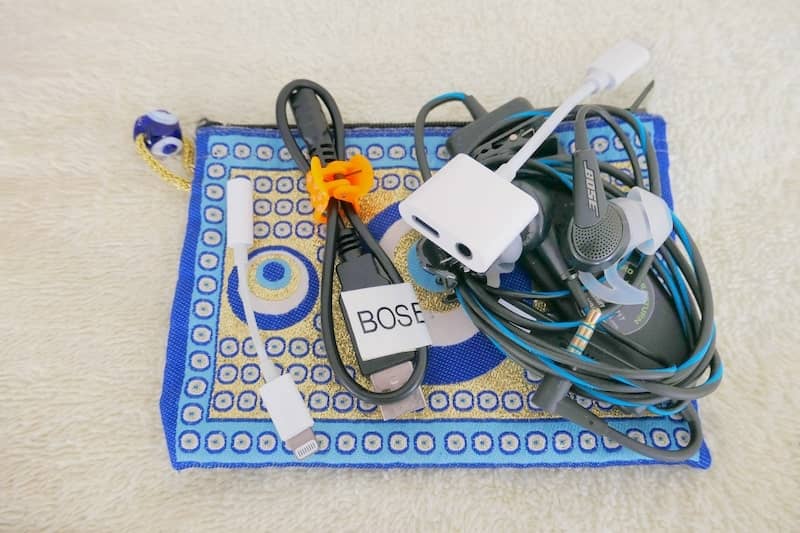
When quickly moving to nesting mode, it’s easier to unpack or partially unpack a secondary bag by having easy access to a few pouches, such as first-aid or electronic accessories kits and sliding them into nooks and crannies in the main bag. The post, How to pack small things in your travel bags describes various approaches to using and organizing pouches and other small packing organizers. With fewer contents, the secondary bag can lie flat or squished into available space.
9. Work with a packing list
As much as 80 per cent of what you pack applies to all trips, so I advise creating an electronic version of a master packing list.
Break it into categories, such as clothing and toiletries, and add separate sections for activity-specific gear for cycling, skiing, or camping. Before a trip, I like to work with a printed copy and check off items I intend to pack. Another approach is to lay out everything in a staging area and check off things as they’re packed. Working with a hard copy encourages making notes and flagging items to be packed within a few hours of departure. A packing list minimizes stress by encouraging an efficient approach to what goes in your luggage. It can deter overpacking while ensuring critical items are included.
10. Take advantage of ‘freebies’
Many accommodation providers stock toiletries for guests. Taking advantage of these offerings where it makes sense means packing less from home.
If you’re an avid miles-and-points hobbyist like me, you’ll likely have access to business-class flights. I had the privilege of securing most segments in business class on my itinerary from Canada to Africa. Business-class amenity kits include toiletries, earplugs, sleep masks, pyjamas, and slippers. As a result, I didn’t pack earplugs, body lotion, and a sleep mask. The slippers in the LOT Polish Airlines amenity kit on the flight from JFK to Warsaw accompanied me for several weeks.
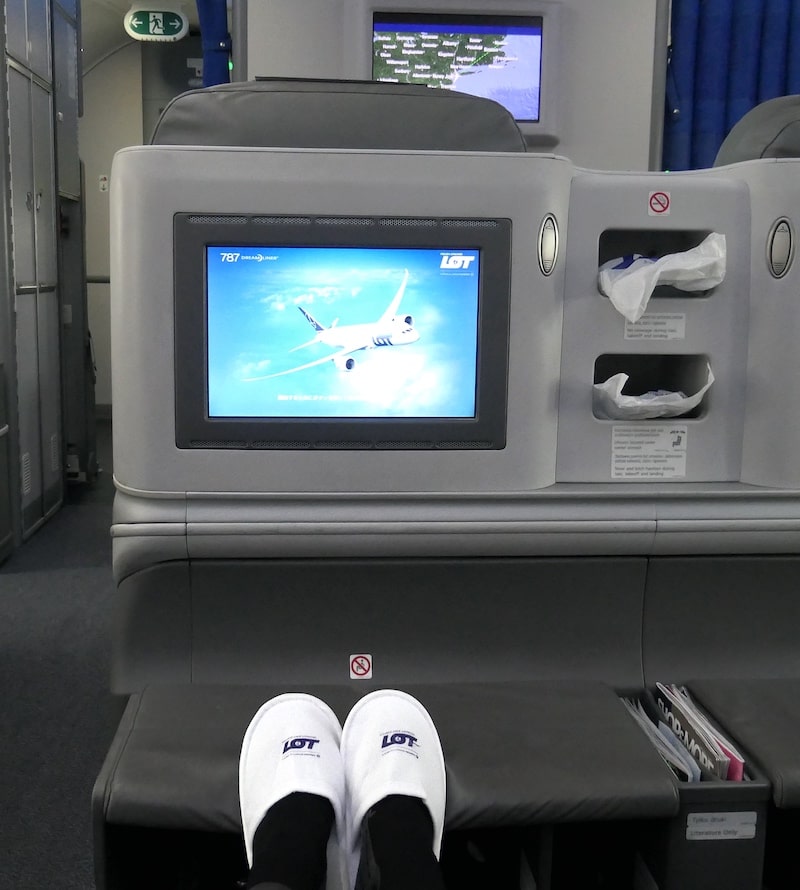
Packing list: 46 days of one-bag carry-on travel by nesting
Here is my detailed one-bag packing list for my 46-day trip to Africa from August 28 to October 12, 2023.
ESSENTIALS
- passport in protective case and RFID-blocking sleeve (Pacsafe)
- trusted traveller card (NEXUS) in RFID-blocking sleeve
- identity bracelet (RoadID Wrist ID Elite 13 mm)
- laminated emergency contact cards (4) for wallet, passport sleeve and bags
- laminated copies (3) of passport information pages for each bag and packable purse
- laminated emergency medical insurance policy card
- driver’s licence
- credit/charge cards with backups
- debit/ATM cards (2)
- RFID-blocking sleeves
- printed flight itinerary (Aeroplan)
- currency (CAD, USD, TL)
- currency sleeves and small zip-top coin bags
- transit cards for Istanbul (from a previous trip)
- hidden stashes (CAD 100 in phone case, USD 100 in lip balm, EUR 50 in clothes folder, USD 20 in fake battery, USD 20 in phony lipstick power bank)
- face mask (Sonomask Pro by Sonovia)
- phone (iPhone 14 Pro)
TOILETRIES
Most liquids, gels, creams, and pastes were decanted into travel-sized containers with predicted amounts for the 46-day trip. As it turned out, quantities were close to the mark.
- toothbrush cover
- toothbrush (Woobamboo Slim Soft)
- toothpaste tablets with fluoride (GloBoid 62 tablets)
- dental floss
- deodorant (Crystal Body Deodorant – 40g / 1.4 oz)
- sunscreen lotion (Neutrogena SPF 70 3 oz / 88 ml)
- sunscreen stick (Shiseido 50+ – 20 g / 0.7 oz)
- facial cleanser (The Body Shop Drops of Light Pure Clarifying Foam Wash)
- toner (The Body Shop Aloe Calming Toner)
- facial moisturizer (The Body Shop Roots of Strength)
- moisturizer (Nature’s Aid Moisturizing Skin Gel)
- hydrating facial mist (Mario Badescu)
- cocoa butter stick (Cococare – 28 g / 1 oz)
- soap bar (Dr. Bronner’s Pure-Castile Bar Soap – Lavender – 140 g / 4.9.oz)
- soap bar case (Matador FlatPak Soap Bar Case)
- PUL wet bag for shampoo bar (Etsy: EcoAdorable)
- shampoo bar (Nature’s Aid Fortifying Lavender and Rosemary 70g / 2.47 oz)
- volumizing spray (Bumble and bumble BB Thickening Go Big Plumping Treatment)
- styling cream (Bed Head Manipulator Texturizing Putty)
- nail file
- insect repellent (Great Outdoors, 30% Deet – 45 ml / 1.5 oz)
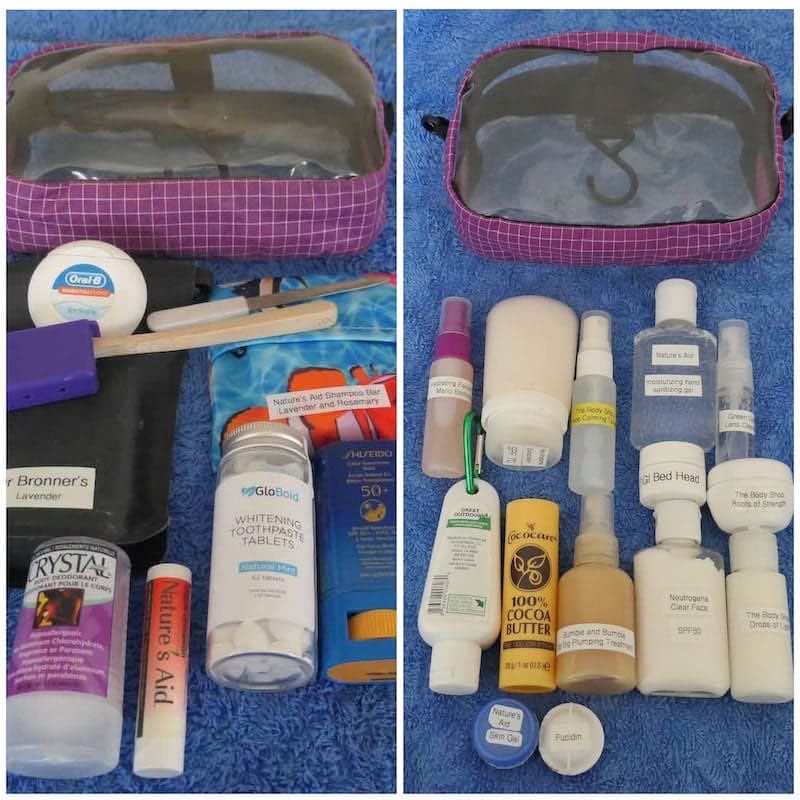
COMFORT PACK
- pocket hand wash leaves (Sea to Summit)
- 6 towel tablets (P4X bamboo towels)
- 4-ply bamboo tissue travel pack (Terre and The Cheeky Panda)
- hand sanitizer (Nature’s Aid)
- lip balm (Nature’s Aid natural)
- sanitizing wipes (Purell)
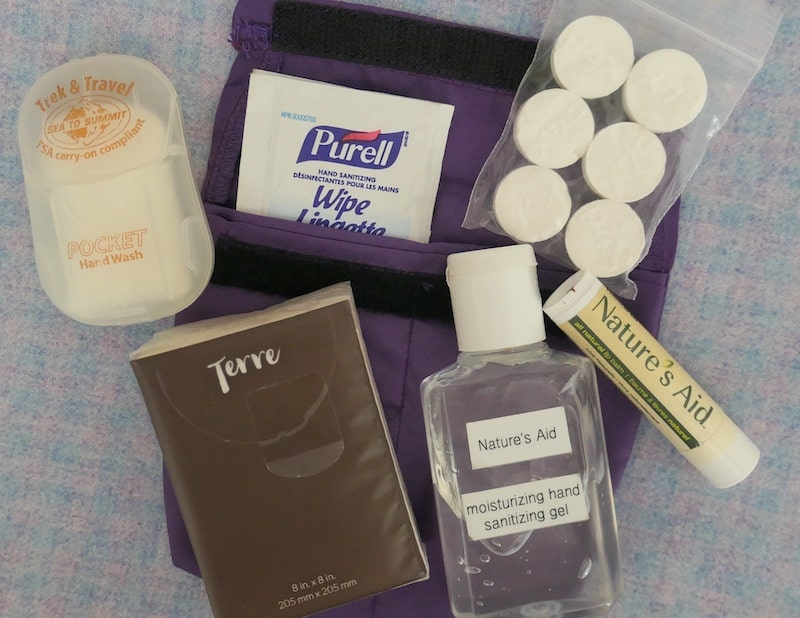
CLOTHING, FOOTWEAR and ACCESSORIES
Shoes and Socks
- walking shoes (Allbirds Wool Runners)
- walking sandals (Teva Tirra)
- flip-flops (Havaianas Slim)
- grip socks (LA Active)
- merino socks (Smartwool – 2 pairs)
- compression socks (Rikedom Sports Graduated Compression Socks 15 – 20 mmHg)
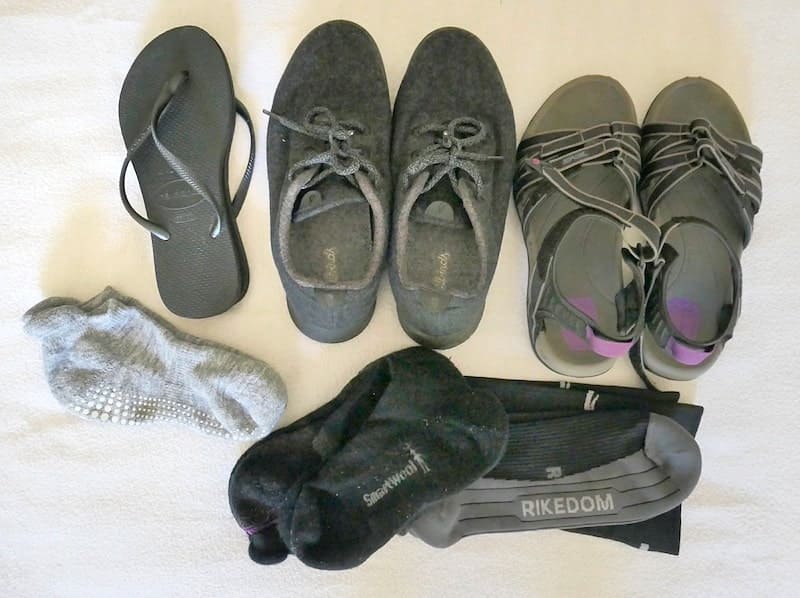
Underwear
- quick-dry underwear (ExOfficio Give ‘Go; Terramar Seamless Performance Bikini; Stay GLDN/Branwyn Essential Bikini)
- reusable panty liners (Etsy: Lily Pads)
- Pocket Panties (H&R, anti-pickpocket, double as shorts/loungewear)
- bra top (The T-Shirt Bra, PINK / Victoria’s Secret)
- bralette (Stay GLDN, now BRANWYN)
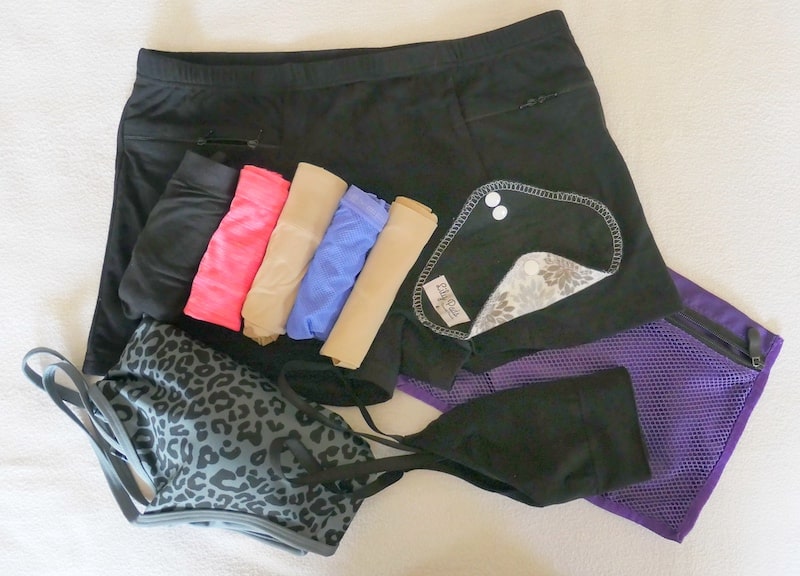
Bottoms
- travel pants (Eikowada – two zippered side pockets, two back pockets)
- leggings (Lululemon Fast and Free 7/8 Tight II – three waist pockets, two side pockets)
Outerwear
- lightweight vest (Scottevest SeV: 20 pockets)
- waterproof, windproof rain jacket (Arc’teryx Norvan SL Hoody)
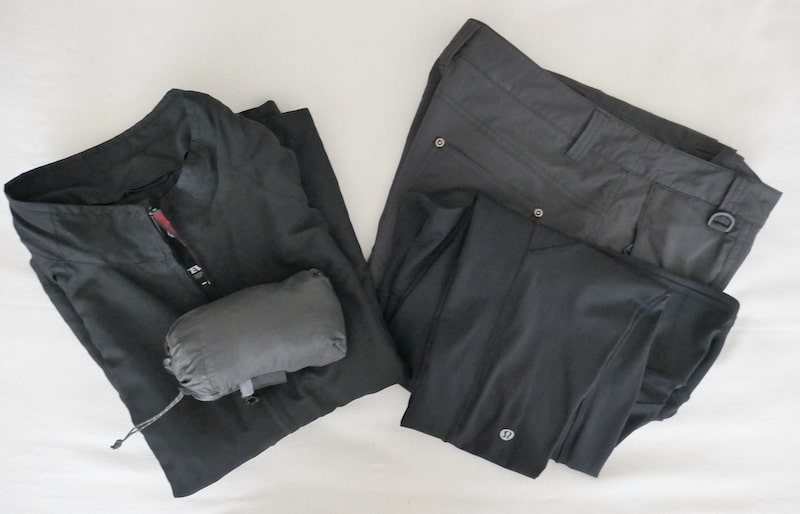
Tops
- short-sleeved shirt with pockets (Eddie Bauer Guide Shirt – three pockets)
- long-sleeved shirt (Columbia Silver Ridge)
- (2) base layer short-sleeved tops (Icebreaker Tech Lite Crewe 150 87% merino)
- long-sleeved base layer (Icebreaker Comet Long Sleeve Half Zip 150 82% merino)
- long-sleeved hoody (Icebreaker Quantum Zip Hood Gritstone 100% merino, three zippered pockets, two internal dump pockets)
- shirt to double as sleepwear
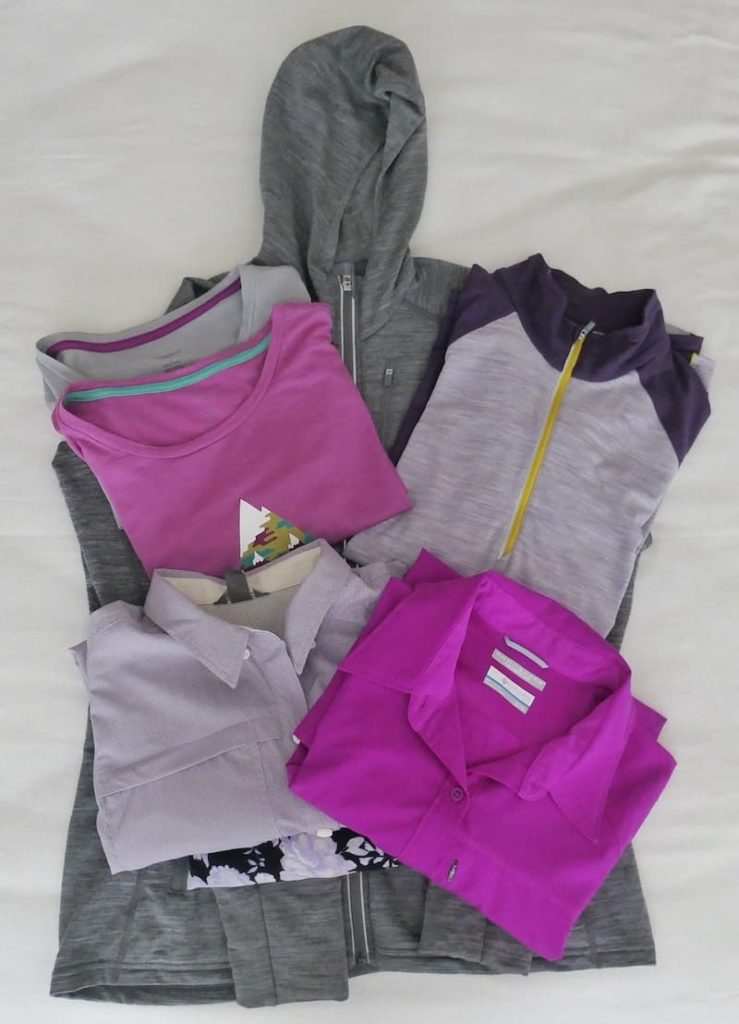
Scarves/Headwear
- pashmina
- reversible neckwarmer wool Buff (pink/lilac, 100% merino)
- sun hat (Columbia Schooner Bank Cachalot III Sage, one size unisex with a Croakies Lid Latch)
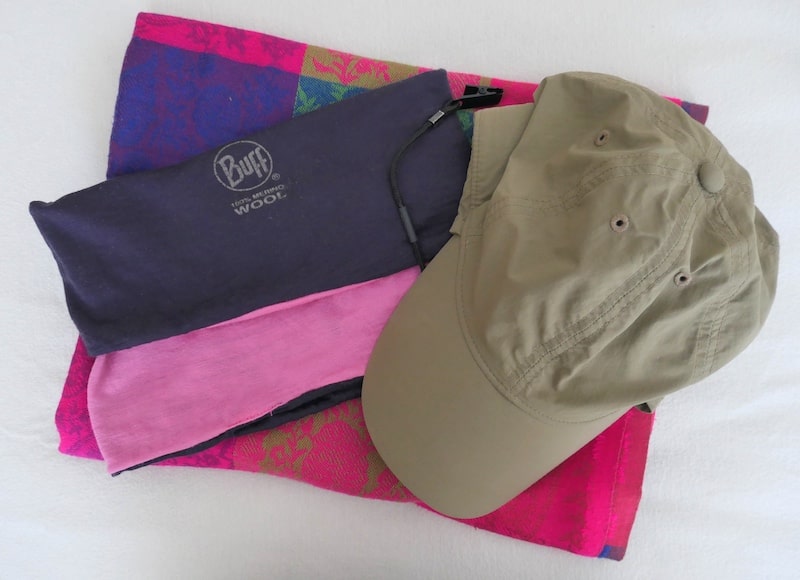
Other
- two-piece swimsuit (Modily; bottoms have side pockets and double as shorts, top doubles as a shirt)
- bling: ring, earrings (in small pouch)

LAUNDRY
- twisted nylon travelling clothesline (Go Travel)
LUGGAGE and ACCESSORIES
- wheeled carry-on (Osprey Daylite Carry-On Wheeled 40 Travel Pack)
- luggage strap bag bungee (GuanjunX)
- foldable stuffable backpack (Osprey Ultralight Dry Stuff Pack)
- packable crossbody purse (Tom Bihn Side Kick)
- RFID-blocking travel waist wallet (Pacsafe RFID Safe 100)
- RFID wallet with D-ring (FurArt)
- diversion safes (SecretStash USB Charger; Duracell battery)
- pocket shopping bag
- whistle (JetScream 122 decibels floating whistle attached to purse)
- Web Dominators (to tame backpack strap webbing)
- stainless steel wire keychain cable
- elasticized, adjustable straps with Velcro (Dollar Store)
- hook and loop Velcro straps (Redpoint)
- retractable coil spring keychain with lobster clasps (PATIKIL)
- cable (Eagle Creek)
- Triple Cable Lock
- inside luggage ID (in page protector)
- external luggage tag (Ovener black aluminum)
Packing organizers
- 3D clear organizer cubes (2) with hook for 3-1-1 bag and non-liquids (Tom Bihn)
- laundry bag (hand-made)
- mesh pockets (Magellans Stowaway)
- Eagle Creek Pack-It Specter Compression Cube Set
- shoe bags (Lewis N Clark)
- packing cubes (eBags) for shirts
- packing envelope (eBags) for underwear
- small yarn stuff sack (Tom Bihn) for tech accessories
- zippered case for itinerary, transit cards, receipts/collectibles (eBags)
- dry bag (Outdoor Research Dry Ditty Sacks)
GADGETS
- point-and-shoot camera (Panasonic Lumix DC-ZS200 with SanDisk Extreme SDHC UHS-1 400X 16GB), soft glasses case, charger
- iPhone 14 Pro, charger, lightening to jack adapter, SIM card remover tool
- wallet phone case (Silk iPhone 14 Pro Wallet Case – Smartish Wallet Slayer Vol. 1 Slim Wallet Case Black Tie Affair)
- phone tether tab with adhesive (Cocases)
- SIM card case (ENGAO 6 Nano SIM holder)
- iPad Mini, USB charger; camera adapters (Lightning to SD Card Camera Reader)
- Cleaner/polish wipes (iKlear Travel Singles)
- keychain charger cable, 6-in-one (Rolling Square inCharge X)
- Air Tags (Apple) and silicone case keychain (Hatalkin)
- in-ear noise-cancelling headphones (Bose Quiet Comfort 20)
- in-ear headphones (Bose SoundTrue Ultra)
- lightning to jack adapters (2)
- power bank and charger (TG90 10,000mAh)
- phone lanyard connector card with adhesive (FMAURE)
- AC to USB Power Adapter (Lencent 45W Multiple USB Wall Charger with International Adapters – UK, EU, US, AU adapters
- South Africa (Type M) adapter with USB-A and USB-C ports (Vintar)
- USB data blocker (PortaPow 3rd Generation)
- personal alarm on keyring (Sabre) attached to purse
- whistle (Jet Scream) attached to purse
- compass (Suunto Clipper) attached to backpack
- flashlight (Olight I1R 2 Pro EOS 180 Lumens Rechargeable EDC Key Chain)
MISCELLANEOUS
- needle and thread (packed in pocket handwash case)
- duct tape card
- emergency reading glasses (ThinOPTICS)
- sunglasses, retainer (Croakies terra cord max), padded pouch
- cloths, lens wipes
- water bottle with Active Loop and Bottle Movement Sleeve (LARQ)
- multi-tool (Nite Ize DoohicKey Key Tool) attached to backpack
- pen (Zebra Mini Ballpoint)
- business cards
WELLNESS SUPPLIES
- sanitizing wipes for plane (EO, lavender)
- oil of oregano (Natural Factors)
- Saccaromyces boulardii (Naka Platinum 10 billion)
- Multivitamin drink mix (Ener-C cranberry)
- hydration tablets (nuun sport)
- activated charcoal capsules (Organika)
- grapefruit seed extract (Nutribiotic)
- black elderberry pastilles (Sambucol)
- Amoxicillin clavulanic acid 875/125mg (antibiotic)
- Azithromycin dihydrate 250mg
- Budesonide 400mcg puffer
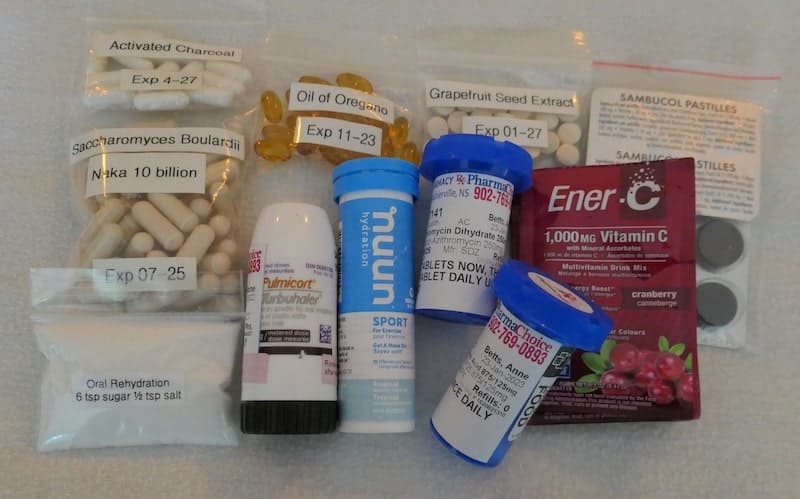
FIRST-AID KIT
Selection of OTC medication and first-aid supplies that fit in a soft-sided Tom Bihn organizer. See 15 Tips on how to assemble a perfect travel first-aid kit for details.

One bag carry-on travel by nesting in practice
Everything on my one-bag packing list fits in a standard carry-on 40-litre suitcase or backpack. When might a secondary bag emerge from the main bag, and what does it contain? It depends on several factors, including weather conditions, type of activity, required level of security, airline carry-on restrictions, or the most convenient way to carry what’s needed.
(i) Clothing with pockets
As mentioned, my 20-pocket SCOTTeVEST Lightweight Vest might be sufficient to carry what’s needed for a short flight or when it’s handy to carry a phone, wallet, sunglasses, and a few comfort essentials. It’s also useful for discount carriers or any flight with a carry-on limit of one bag. When packed away, the Eagle Creek Pack-It Specter Compression Cube minimizes the space it consumes in a bag.
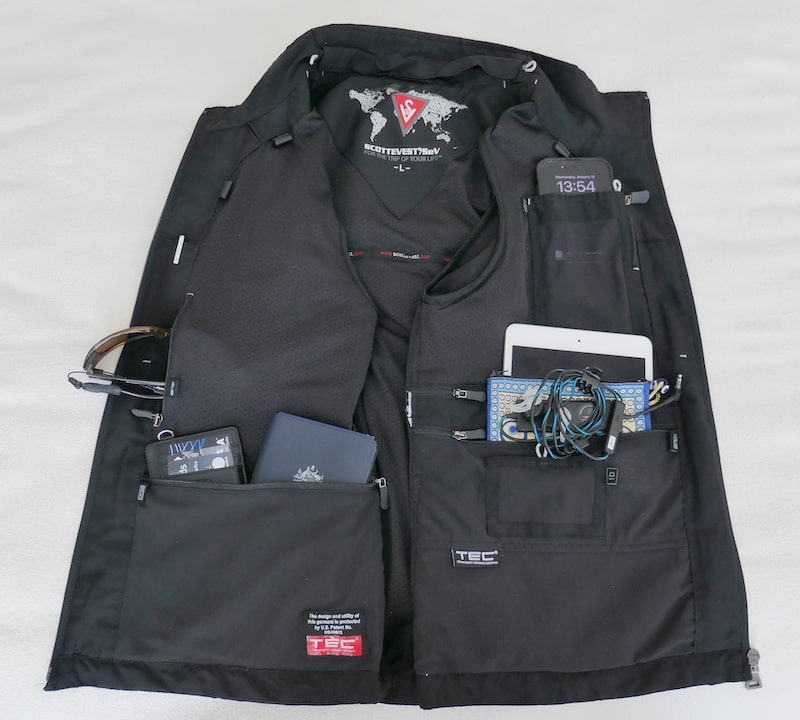
(ii) Packable purse
A packable crossbody purse can carry similar items. Like a travel vest, it can be worn door to door on travel days, removed only at airport security screening points when stuffed into the main bag (or personal item).
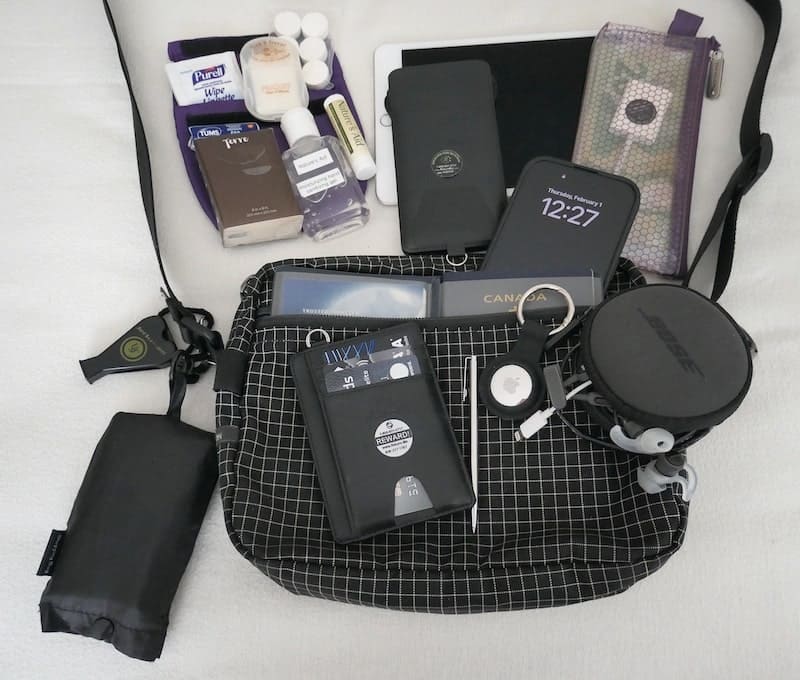
(iii) Packable backpack
A packable backpack (or other packable bag) has the edge on a purse or travel vest because it can carry a range of essentials for long flights. It can also accommodate clothing layers for layering up or down. Depending on the shape and volume of a reusable water bottle (and the design of a personal item/day bag), a packable backpack may be a better choice for carrying a water bottle.
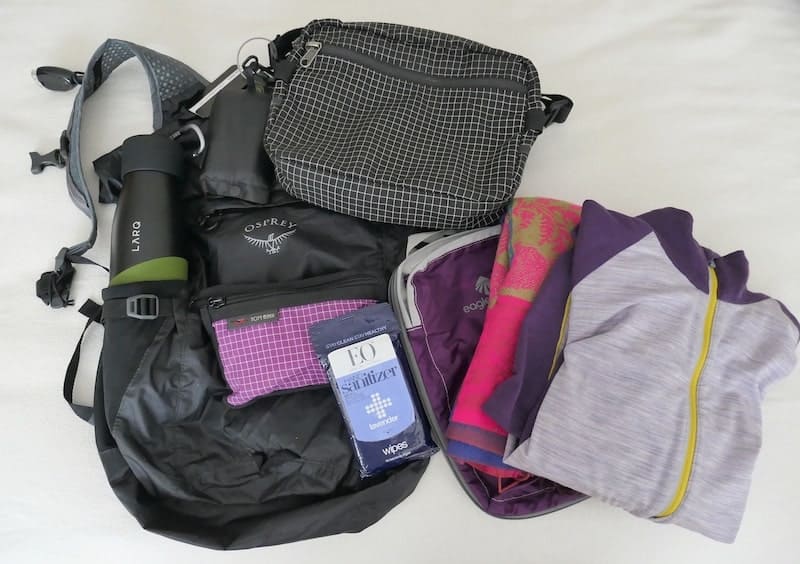
(iv) Standard carry-on bag
Packing cubes, pouches, and other packing organizers help organize, protect, and compress what’s packed in the main bag. Stuff is easy to squeeze into nooks and crannies while remaining organized, making it easier and faster to move to and from nesting mode.
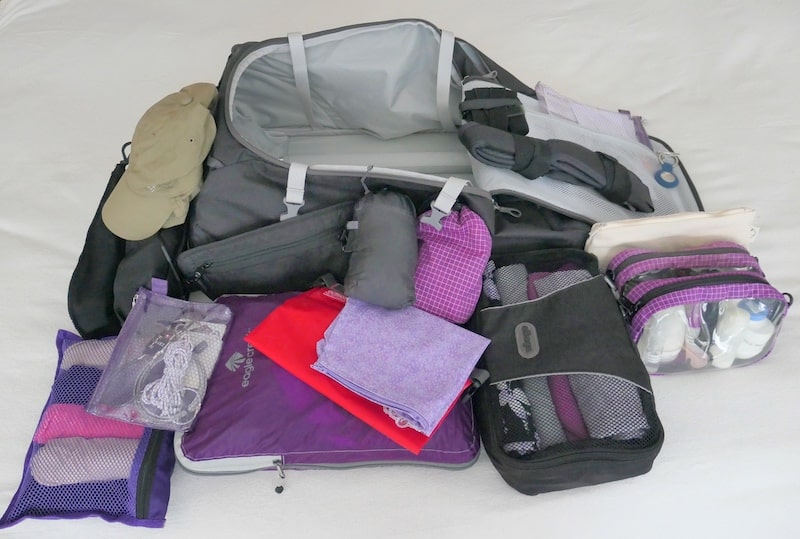
Once stuff that’s unlikely to be carried in one of the secondary bags is packed, there’s a lot of space to accommodate empty, packed, or partially packed secondary bags.
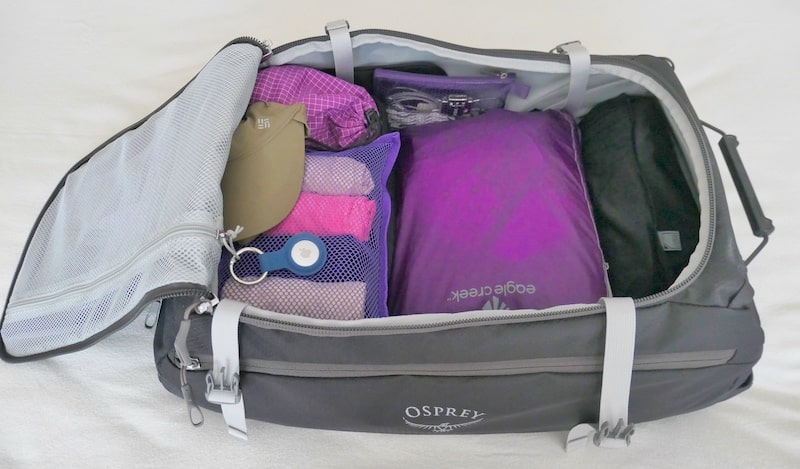
Conclusion
One-bag carry-on travel encourages a considered approach to minimizing what’s packed to maximize the experience. Nesting offers the flexibility to travel with additional bags while remaining committed to the principles and benefits of one-bag travel.
Might you be interested in these related posts? They elaborate on many items on my packing list.
- Top 20 tips on how to pack light
- Why Allbirds Merino Wool Runners are my Favourite Travel Shoes
- A Matador Flatpak Soap Bar Case Review for travellers
- Travel with tablet towels: a multipurpose essential every traveller should pack
- No soap? No problem travelling with soap leaves
- Pack light with bar shampoo
- Pack light with a travel-friendly portable power bank
- Pack light with a USB to AC international travel charger
- Packing list and tips for doing laundry while travelling
- 18 Tips on organizing a 3-1-1 bag for toiletries and cosmetics
- How to pack small things in your travel bags
- Functional and lightweight shoe bags for the packing light traveller
- Buff: a multipurpose essential for the packing light traveller
- Always pack a pashmina: one of the best multipurpose items in a travel bag
- 6 Disadvantages of the ‘buy-it-there’ approach to packing light
- Tame dangling straps with Web Dominator
- 6 reasons to carry laminated copies of your passport
- How to make a traveller’s emergency contact card in 5 easy steps
- Travelling with duct tape: 30 practical uses
- Go natural. But does crystal deodorant work?
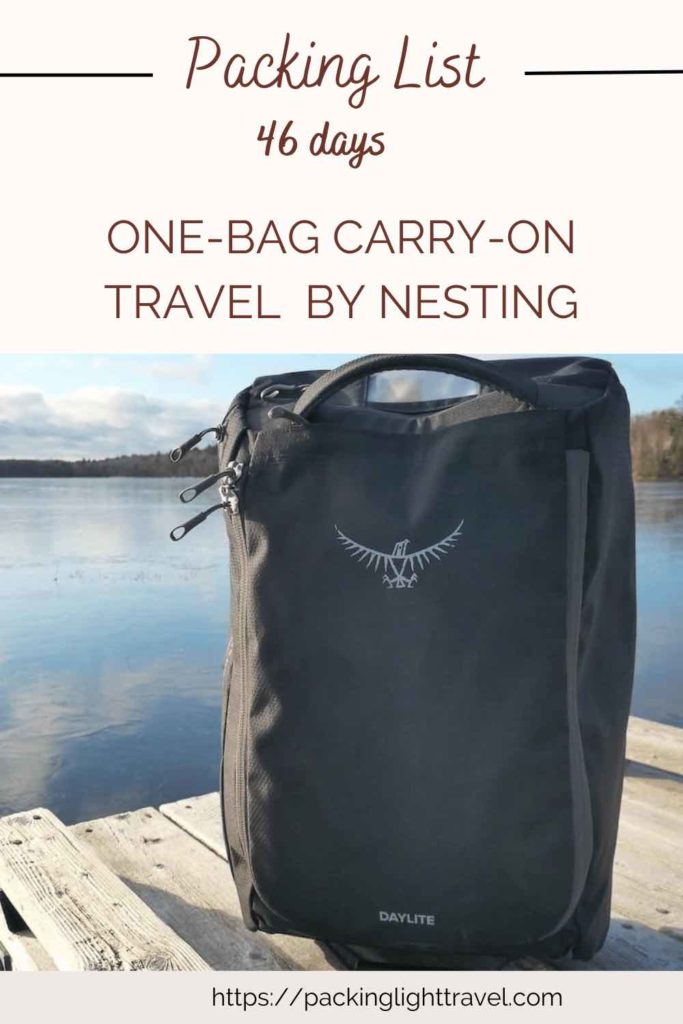
The Amazon links in this post are affiliate links. If you click on one and purchase something, you don’t pay more but Packing Light Travel earns a small commission which helps with the costs of maintaining the site. Thank you for your support. It’s appreciated.






Thanks Ann!
This helps.
While I love my Ebags Pack-it-Flat toiletry kit, I can’t really use the side pocket that is lined because of the separate 3-1-1 requirement. And I really should have separate 1st Aid, Comfort and McGyver bags because I’d most likely want those in my day-pack, not back at the room in my wonderful Pack-it Flat kit.
Same with electronic stuff. Nice to have the phone and computer cords, plugs, chargers in one bag, but it’s easier to Tetris if they are in separate bags. Plus keeping the phone and computer stuff separate makes it easier to move to the day-pack when you aren’t taking both.
I did utilize the nesting approach on my last trip. I put a packing cube with overnight/change of clothes inside my day-pack along with overnight toiletries which went inside my under-seat bag. I pack light, but check my “carry-on” size suitcase because I don’t want to lift it overhead or keep up with it in the airport. I always take a bag in the cabin with overnight stuff in case my checked luggage doesn’t make it with me or I get stuck in transit and don’t want to retrieve my checked bag to spend the night at the airport hotel.
Surprisingly, even though the day-pack would lay pretty flat in the under-seater, the under-seater was less “stuffed” with the day-pack filled instead of lying empty in the bottom or top of the bag. ???
Thanks for adding details with pictures.
No worries. Thank you for the suggestion and I’m pleased it was helpful. I also had a larger hanging toiletries kit but I much prefer a zippered see-through one-litre/quart bag (with a hook) that doubles as a ‘liquids’ bag. I liked the Tom Bihn 3-D Organizer Cube so much that I bought another one for non-liquids. Both are much easier to pack. All the best.
I really enjoyed this article on one-bag carry-on travel! The nesting technique is a game changer for minimizing space and keeping everything organized. I’ve always struggled with overpacking, but this approach makes it feel so much more manageable. Thanks for sharing such practical tips!